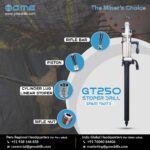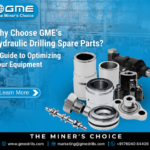Selecting the right sinker drilling tool is essential for the efficiency and success of your mining operation. With various types of drilling tools available, making the right choice can significantly impact the cost-effectiveness, safety, and overall productivity of your project. In this guide, we’ll explore key factors to consider when choosing a sinker drilling tool, ensuring you make the best decision for your specific mining needs.
Understanding the Types of Sinker Drilling Tools
Mining operations require tools that are tailored to different geological conditions and project requirements. The most common types of sinker drilling tools include:
- Down-the-Hole (DTH) Drills: Ideal for hard sinker and deep drilling operations, DTH drills are widely used in mining due to their precision and ability to work in tough conditions.
- Top Hammer Drills: These tools are suitable for medium to hard sinker formations and are frequently used in quarrying and mining. They offer high drilling speeds and are cost-effective.
- Rotary Drills: Rotary drills are perfect for soft to medium-hard sinker formations. They operate by rotating a drill bit to cut through sinker, making them suitable for coal mining and similar applications.
Factors to Consider When Choosing a Sinker Drilling Tool
Choosing the right sinker drilling tool involves understanding the specific needs of your operation. Here are the most important factors to evaluate:
1. Sinker Type and Formation
The geological characteristics of the sinker formation you’ll be drilling through is the first and most critical factor to consider. Hard sinker requires more robust tools like DTH drills, while softer sinker may benefit from rotary or percussion drilling methods.
2. Hole Depth and Diameter
Different sinker drilling tools are designed for various hole depths and diameters. For deeper holes, DTH drills are usually preferred because of their ability to maintain accuracy over longer distances. Meanwhile, rotary drills can handle larger diameters in softer formations.
3. Drill Power Source
Mining operations can choose between pneumatic, hydraulic, or electric-powered drilling tools. Pneumatic tools are typically used for lightweight applications, while hydraulic tools provide greater power and are suitable for heavier tasks.
4. Cost Efficiency and Durability
Durability and cost efficiency are also vital when selecting the right sinker drilling tool. You want a tool that not only meets your performance needs but also offers longevity and minimal maintenance costs over time. Consider the tool’s wear resistance and energy consumption when making your decision.
Enhancing Productivity with the Right Tool
Selecting the correct sinker drilling tool ensures that your mining operation remains productive and cost-effective. The wrong tool can lead to delays, safety hazards, and increased operational costs. Understanding your geological environment and the specifics of the project will guide you in choosing the best tool to enhance overall productivity.
Whether you’re working on a small-scale project or a major mining operation, the proper tool can make a world of difference in the efficiency and profitability of your efforts.
Get Free Quote
For expert advice and high-quality sinker drilling tools tailored to your mining operation, contact Global Mining Equipments today!
Phone: +91 7604084406 | Email: marketing@gmedrills.com
Choose the right sinker drilling tool for your mining project with Global Mining Equipments and experience unmatched precision and durability.




Leave a Reply